Questions and Answers: April 2014
This is one of the most-read portions of e-gardens each month. Neil selects the six or eight questions that he feels will offer the broadest reader interest. He requires that each question be accompanied with a supportive photo, and he requests that you also tell him your city, as answers will vary from one part of our great state to another. Click here to send Neil your question and photo for the next issue of e-gardens. We’ve had many questions sent in this time. Neil tells us he’ll answer as many as possible, although he may need to give somewhat more concise replies than usual, just in the interest of real time and virtual space.
Here are his answers to your recent questions.
Question: Is it advisable to plant a new tree in the same location where one was just removed? I will have the stump ground out. The old tree was a willow oak, and I’m replacing it with either a bur oak or a Shumard red oak. M.W., no city given.
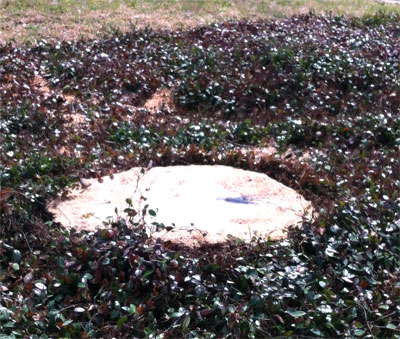
Answer: I have to admit that I usually prefer to move a few feet away from the old planting spot. Stump grinders only take a portion of the old root system out. There is a great deal of organic matter that remains behind, and that can tie up nitrogen for several years. And all of that presumes that whatever killed the old tree isn’t something that will hang around and bother the new tree. With your willow oak, that would probably not be an issue. If you can accomplish good landscape design and move the tree just a few feet away, go for it. If it must be in the same spot, have them go extra deep and extra far with the stump grinding.
Question: What is this hairy, thread-like growth on the branch of a star magnolia tree? I washed the growth off last summer with a weakened bleach and water solution, but it came back and eventually consumed that entire portion of the tree. I suspect that the tree is a goner, but will it spread to other plants? T.S., Colmesneil.

Answer: That’s a very interesting question. (My translation from, “Wow. There’s one I haven’t seen before.”) It may be fungal strands and fruiting bodies from a disease that is killing the tree’s tissues. It could also be a saprophytic fungus that is merely developing as the tree’s tissues, already dead from some other cause, decay. The Plant Disease Diagnostic Laboratory at Texas A&M would be able to culture samples from the branch and identify it for you. I agree with your assessment that the tree will probably need to be replaced, but I would not expect the problem to spread to other trees, especially to other species. Sorry I couldn’t get closer, but that’s at least a start.
Question: We moved into this house two years ago, and the Leyland cypresses were in terrible shape. Bagworms had stripped them. We removed one tree, and we were diligent to keep the bagworms off last spring and early summer. Now we are seeing lower branches turning yellow and rusty. It starts on one and eventually affects all of them. Is there anything more we can do? No name, no city given.
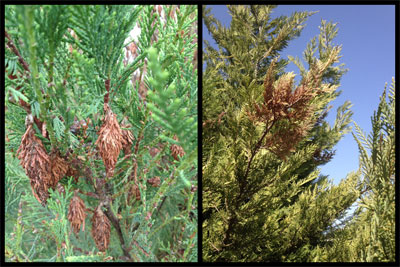
Answer: I’m really fearful that your Leyland cypresses, like tens of thousands before them across Texas, are succumbing to Seridium canker. Here is important information on the disease.
You really need to start thinking about what species you will plant to replace them. In most of Texas, eastern redcedar is the best option. It grows to be the same 30 to 35 feet tall as the Leyland cypress should grow, but eastern redcedar doesn’t have all the same problems.
Question: We have had incredible problems getting things to grow in these west-facing beds. They get so hot in the summer that nothing survives. What are some of our best options in heat-proof plants for these spaces? V.G., near Cleburne.
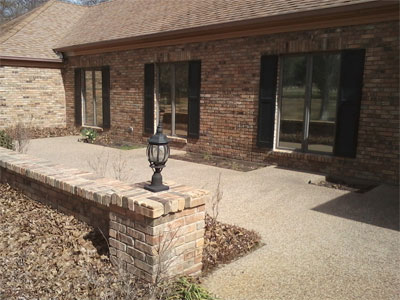
Answer: I’m sure these beds can be boiling hot when even the air temperature is 105 F. With all that reflective material, they’re even hotter, I’m sure. But there are plenty of plants that will be able to handle it. Water is the secret. If you’re careful to water regularly and deeply, spring plants can be just fine. Tam junipers, Asian jasmine and purple wintercreeper euonymus will all be good sun-tolerant groundcovers. Sea Green juniper would be excellent for a 5-foot-tall screening plant if you need one. Dwarf yaupon holly and dwarf Burford holly would both handle the sun and heat, although you would have to be very mindful of their water needs. Neither plant wilts when it’s dry, so you would need to get in the habit of sticking your finger down into the soil every day without fail. Dwarf abelias would do well, and I’d certainly give Harbour Dwarf and compact nandinas a try, although maybe not in the very most foreboding of the spaces. Annual color could come from firebush, copper plants, trailing lantanas, purslane, Gold Star esperanza, moss rose, Dahlberg daisies, pentas and purple fountaingrass. Many perennials would also do very well there.
Question: Several of the branches of my red oak snapped during the ice storm. The arborists trimmed a couple of limbs in a way that reminds me of crape myrtle topping. I assume branches like those shown in the photo should have been cut back to the trunk? Does this work look acceptable to you? M.McD., Plano.
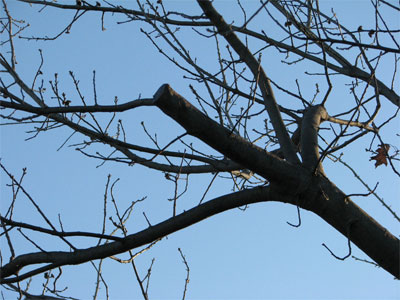
Answer: It looks spot-on. My poor little Lacey oak suffered the same damage from the same storm in the same county that you live in. I was able to do my tree’s trimming myself, and my tree looks pretty much like the branches you have shown. Because there is already a side branch growing at that location, your arborist obviously was hoping that the tree would put energy into regrowing branches to help it rebuild its canopy. Don’t worry at this point. If you have the arborist scheduled for an annual check-up, he’ll be watching it for you.
Question: These two plants were set out at the same time. Same bed. Same water. Same everything. They are about six years old. One looks like it’s dying, and the other looks fine. Any suggestions? R., Celina.
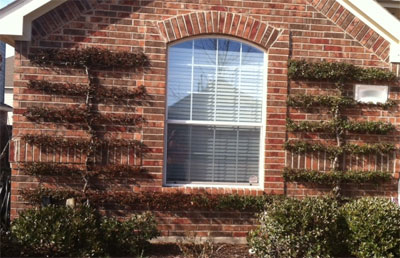
Answer: Your espaliers are pyracanthas. Typically they are great choices for this very specialized training. However, pyracanthas have several significant problems when they’re grown in Texas. The worst problem is the soil-borne fungus cotton root rot. It is present in alkaline soils (such as yours), and it can be dormant in the soil for years before it reaches out and kills an isolated plant. Once present, it can kill other susceptible plants nearby, spreading slowly through the soil. If you have lived in Celina long enough, you may recall the cotton fields that used to be on the south side of Preston and US 380. As you’d drive over the railroad bridge, you could look down and see half of each field killed by CRR, so the fungus is that close to your home. There is no control for it other than to replant with a resistant species such as one of the hollies or Hollywood twisted juniper for espaliers. If the problem’s not CRR, it could be fire blight (doesn’t look like it), or it might be old damage from last summer done by lacebugs or leaf rollers. Both of those can be addressed easily with systemic insecticide drench made in early May. I fear, however, that it’s CRR. The Plant Disease Diagnostic Lab at Texas A&M could look at a good sample of the roots (no soil needed, but do not wash the roots) and decide if that was the cause.
Question: We are trying to rework beds in front of our house and elsewhere. We want to feature perennials that will attract butterflies and hummingbirds. We can use annuals, but need to limit their numbers to keep costs affordable. What would you suggest for our harsh climate? R.M., Waco.
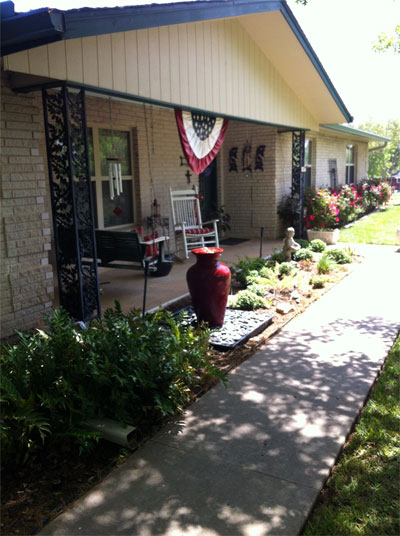
Answer: Butterflies and hummingbirds favor plants with tubular flowers. The various salvias would be great starters, most specifically autumn sage, Salvia greggii. It’s a handsome, low shrubby type that can be used almost like you might use Japanese boxwood. It also blooms for a prolonged period of time. Flame anisacanthus is another good hummingbird plant, and it should be winter-hardy in Waco most winters. Annuals like firebush and the various pentas are great for both hummingbirds and butterflies, and both will bloom from the time they are planted clear up until frost, so they give you a huge bang for your buck.
Question: A mostly intermittent stream forms the back property line of our land. It runs with a strong current for a few days after heavy rains. Usually there is some water flowing. It the middle of the summer, it may consist solely of disconnected pools. What can we plant to stop erosion from the bank? I like cattails. Would they work? (Photo was taken at 5 p.m. on a cloudy day. The area does get some sunshine. I don’t know how much.) A.B., Bryan.
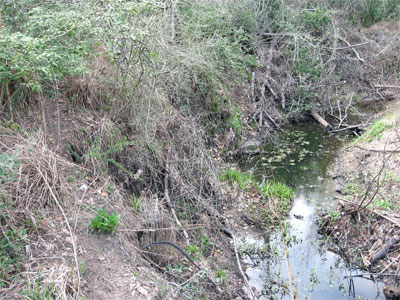
Answer: I guess I’ve just seen so many people work so hard to get rid of cattails that I have a difficult time endorsing them. Plus, the erosion would be from the top and side of the bank, and cattails would end up growing in the water. They would also stop debris and possibly create an eyesore. Since your property is on the outside of the curve of the streambed, that surface takes the full impact of the rushing water. You might try clearing the brush away (without loosening the soil and tearing out existing roots), so that you could plant Japanese purpleleaf honeysuckle. It’s a good rough-use tall groundcover. However, the surrounding area looks rather undeveloped, and if that’s your preference, the honeysuckle would not be a good solution. Is there any way to have a landscape contractor come in with interlocking ledgestones or with some other form of riprap stone? It could be placed attractively, and eventually vines could be planted to tumble down over it. Honestly, you really need to talk to a veteran landscape contractor as you show him or her the entire streambed. Because of prior experiences and training, that person will be prepared to discuss landscaping options you have available. Talk to the Soil Conservation Service for suggestions. This is right up their alley. You’ll find something that fits your needs, your goals and your budget.
Question: What small trees or shrubs would grow in almost total shade? I want to block the neighbor’s view, but I want to be able to see the lovely stone wall. Burford holly did not do well for me. No name given. No city listed.
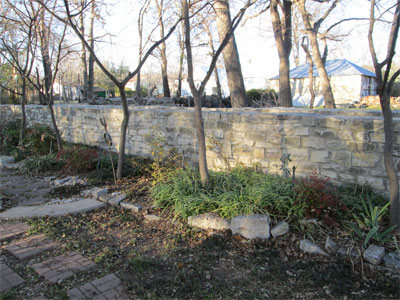
Answer: Japanese maples, redbuds, tree-form yaupon hollies and even tree-form Nellie R. Stevens hollies would all be useful. Warren’s Red possumhaw holly would be colorful in the winter, with its large red berries, even though it’s deciduous. Teddy Bear magnolias are even shorter than Little Gem. Either could work well if it got uniform sunlight from all directions.
Question: In 50 years of growing African violets, I have never had powdery mildew. Almost all of the affected ones in my collection are of this magenta variety. Should I destroy them or dip them into some type of mild bleach? S.S., Paris.
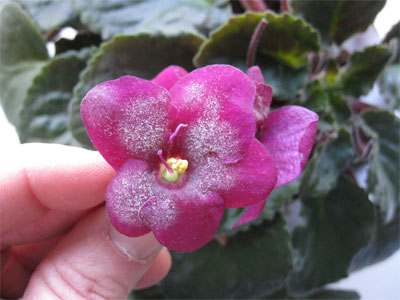
Answer: Hi, my friend! You’re a better grower than I am. Until I found Lechuza pots, I was not a successful African violet grower. As a result, this is somewhat new to me, too. I did a little online research, and here is a link to the disease control page from one of the largest producers of African violet plants. This looks like really useful information: http://www.optimara.com/doctoroptimara/diagnosis/powderymildew.html
Question: We had an air conditioner replacement last summer. The new unit was larger, and it required that we take out one Burford holly. If we wanted to replant one, it would be only a few inches away from the new AC unit. What would you suggest instead? M.S., Hunt County.

Answer: If the hollies are uniformly spaced (must be, hence your concern), then maybe you can’t insert a new holly. In that case, I’d be tempted to buy a pretty piece of decorative free-form wrought iron trellis to play off the color of your furniture. I’d attach it to the wall with a couple of inches of air space between wall and trellis. That would allow you to display garden art, wall planters, whatever. You could also put a wrought iron shelf or hayrack on the wall, or one or three brackets for hanging baskets. Wrought iron can be spray-painted to match the furniture’s color. Or try a large decorative pot that you could fill with purple fountaingrass for the summer.
Question: I have numerous Nana nandinas in my yard. Some face east and some west. They have traditionally turned brilliant red in the winter, but the past two winters they have just stayed green and yellow. I do trim them in early spring to keep them from getting too tall. Any suggestions? C.S., University Park.
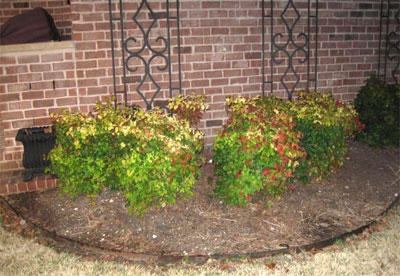
Answer: If the sunlight that hits the bed hasn’t changed, my bet is going to be that they have been there for a good while. My experience with Nana nandinas has been that they have a fairly short life expectancy compared to other nandinas (5 to 10 years). Beyond that, in areas with alkaline soil such as yours, they begin developing iron deficiency symptoms (yellow leaves at the ends of the twigs or branches, with veins retaining their green color the longest). That is what this looks like. They may just be running out of oomph.
Question: We have a line of dwarf Burford hollies in front of our house. They have done well for six years, but last year they started to turn brown and their leaves fell off. We had to pull two plants. We sprayed them and thought we had solved the problem, but now it’s coming back again. What might the cause be? J.F., Shady Shores.
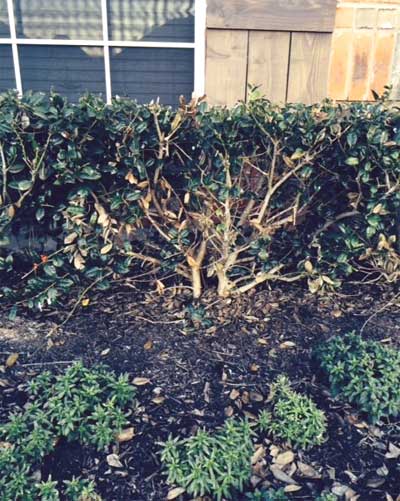
Answer: I can’t think of anything with Burford hollies that would merit spraying of any kind. No serious insect threats and no diseases. I can’t tell what might be wrong from your photo, but the symptoms you described are exactly like what you’d see with a plant that had gotten too dry. Sometimes that can happen without our being aware. Hollies really don’t wilt – they pass the point of no return, changing only to an insipid olive drab color, then brown.
Question: We have two pony tails that have been in our family for more than 50 years. Obviously, they are getting so tall that we have to do something. Can they be cut back without doing serious harm to the plants? S.K., Irving.
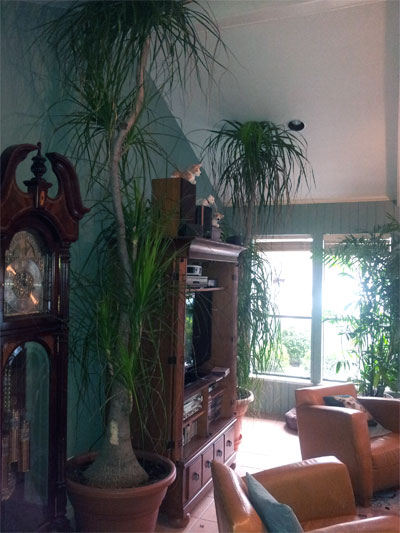
Answer: I have seen many pony tails that have been cut back. In fact, I have a couple of plants that look like they were probably cut back before I bought them. I think you would be fine in doing so. Using the plant I can see better for my example, you could cut the top back to just above either of the next shoots down. The remaining stems would probably start to grow a bit faster at that point.
Question: I paid to have this tree delivered and planted. The ruler is resting on the top of the root system. They had soil up against the trunk, with the landscape fabric wrapped around it like a necktie and then piles of mulch on top of that. The man reminded me that I asked for it to be in a raised bed. It’s been like this since December 24, 2013. I’ve just now pulled the fabric away. Do I need to do more? These are the same people who used a line trimmer to skin up my little tree. No name. No city given.
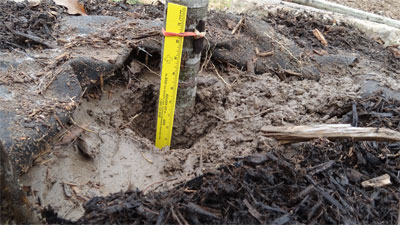
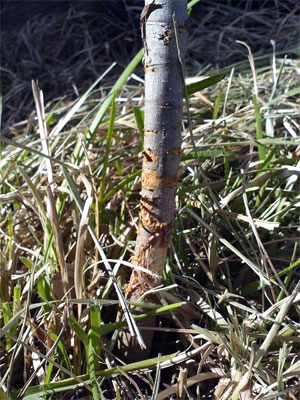 Answer: As much as I want to help you, I really can’t tell from the photo with the ruler what is going on. The tree should have been planted at the same depth at which it was growing originally in the nursery or in the field. If a raised bed was prepared for it prior to planting, it certainly could be planted above the overall grade of your landscape. But if soil was just pulled up around the tree’s soil ball, that doesn’t count. This doesn’t look like it was done very well, but again, I can’t see the situation very well from the one photo. I’d suggest talking to the owner of the company if you have concerns.
Answer: As much as I want to help you, I really can’t tell from the photo with the ruler what is going on. The tree should have been planted at the same depth at which it was growing originally in the nursery or in the field. If a raised bed was prepared for it prior to planting, it certainly could be planted above the overall grade of your landscape. But if soil was just pulled up around the tree’s soil ball, that doesn’t count. This doesn’t look like it was done very well, but again, I can’t see the situation very well from the one photo. I’d suggest talking to the owner of the company if you have concerns.
